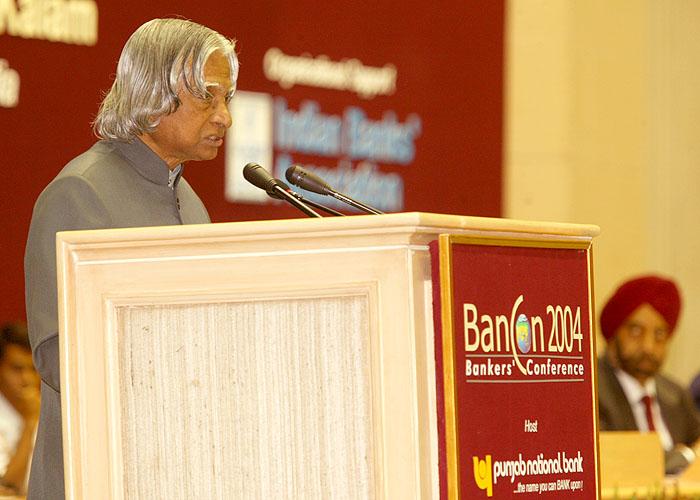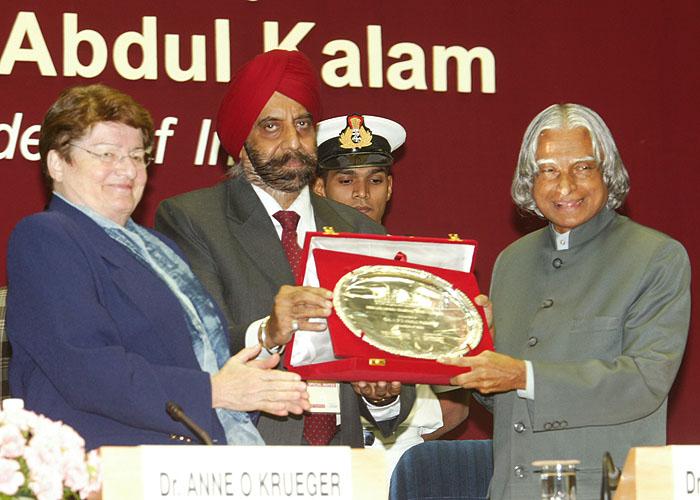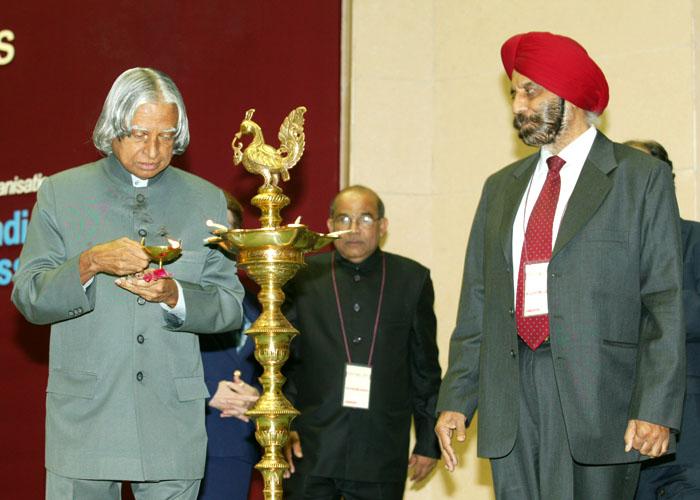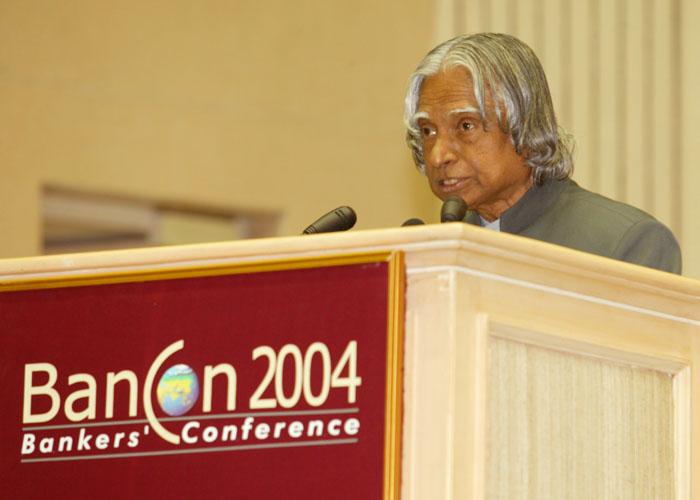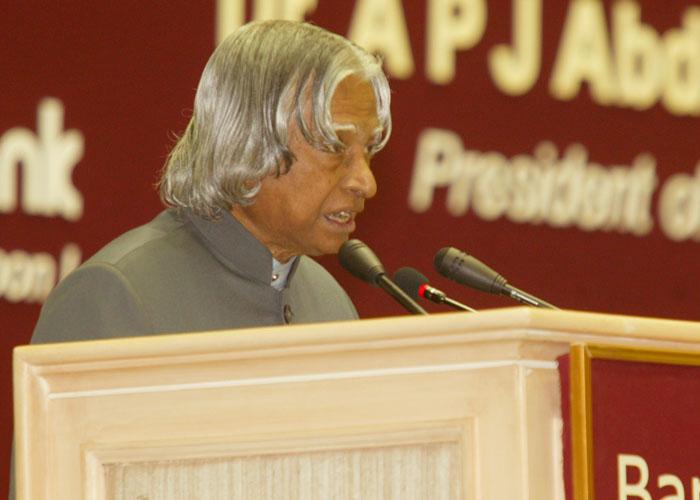Address At The Bankers' Conference 2004
New Delhi : 10-11-2004
Multi-dimensions of Banking
I am delighted to participate in the Bankers' Conference 2004 hosted by Punjab National Bank and the Indian Banks? Association. My greetings to the organizers, senior bankers, economists, policy makers, academicians, government functionaries and distinguished guests.
Ambience in the Nation
In the Indian history, very rarely we have come across a situation, all at a time, an ascending economic trajectory, continuously rising foreign exchange reserve, global recognition of technological competence, energy of 540 million youth, umbilical connectivities of 20 million people of Indian origin in various parts of the planet, and the interest shown by many developed countries to invest in our engineers and scientists including setting up of new R&D centers. Also the national "Common Minimum Programme" of the Government has six basic principles. Three out of them emphasize on economic development by ensuring growth rate of 7% to 8% annually, enhancing the welfare of the farmers and workers and unleashing the creativity of the entrepreneurs, business persons, scientists, engineers and others productive forces of the society.
Our Challenge
Now we have an important mission, the mission of lifting the economic status of 260 million people, who are below the poverty line. I understand that the total annual credit performance of our banks is nearly rupees eight hundred thousand crore ($ 180 billion). In this environment, indeed Bankers have a mission of great challenge. I am sure the economic experts assembled here will be discussing the means of removing the poverty of 260 million people in a time bound manner. Our mission is: Transforming India into a prosperous, happy, peaceful and safe nation, as our youth dream to have. Let me share with you a few thoughts.
Banking and Economic reinforcing
It is well understood that sound fiscal and monetary policies, a trusted and efficient legal system, a stable set up of democratic institutions and progress on social conditions contribute greatly to an economically healthy nation. Wealth is actually created at the micro economic level of the economy rooted in the sophistication of corporate and entrepreneurs as well as in quality of competitive micro economic business environment.
In this connection, I was studying the development patterns and the dynamics of connectivity between nations, especially in trade and business. As you all know the world has a few developed countries and many developing countries. What is the dynamics between them and what connects them? Developed country has to market their products in a competitive way to different countries to remain as developed country. The developing country to get transformed into developed country, too has to market its products to other countries in a competitive way. Competitiveness is the common factor between the two types of the nations. Competitiveness has three dimensions: quality of the product, cost effectiveness and just in time in the market. Indeed this dynamics of competitiveness in marketing of products by developing and developed countries is called the ?law of development?. Hence Indian products whether software or hardware has to compete within the country and in international market.
In this context, banking sector has a tremendous role in reinforcing the economy of the nation, by servicing the micro economic needs of all the three sectors of the economy ? agriculture, manufacturing and services, at the centres of action in the country.
Bank as a venture capital provider
The financial services industry has been in the vanguard in the development phase in all the countries. The proactive approach adopted by many banks has led to phenomenal growth of the country. The days of development financial institutions seem to be over. The current fashion is the Universal Bank. Even the redoubtable IDBI has converted itself in to a Universal Bank shedding the robe of a pure development financial institution. The development finance responsibility with its inherent risks is squarely and fully on the banking sector. It is in this background I wish the bankers to play a positive role to assist the country to march towards development faster.
In India we have the experience of providing venture capital to a number of entrepreneurs. Of course few of them succeeded also. In the present economic situation, it is essential the venture capital business has to increase in magnitude, particularly with hassle free procedures. I have come across a European experience of a physics graduate turning into 100 million dollar exclusive venture capital banker and leading to establishment of a 10 billion dollar company. The chief executive of that company met me two days back with certain dream for India.
Recently the department of Science and Technology (DST) has started Technology Business Incubator (TBI) programme in number of engineering colleges in the country to bring up young and innovative techno entrepreneurs to utilize the infrastructure and knowledge of academy to develop new products ? software and hardware and establish design and process know-how for setting up a product line. The bankers have to scout for prospective entrepreneurs coming out of such programmes and provide venture capital to scale up and lead to quantity production. Actually in this situation there are certain risks. But in the history of great industrial development, risks always accompany success. If only you take such risks, you can reap the benefit of generating billion dollar company. Are you ready?
Road map for Developed India
To achieve the vision of developed India, we have to simultaneously progress five areas where India has core competence for integrated action: (1) Agriculture and food processing (2) Education and Healthcare (3) Information and Communication Technology (4) Infrastructure including Electric power, Networking of rivers, Providing Urban amenities in Rural Areas (PURA) (5) Self reliance in identified critical technologies. These five areas are closely inter-related and if progressed in a mission mode will lead to food security, economic prosperity, social welfare and national security.
The Mission of PURA
The number of PURA units for the whole country is estimated to be 7000. This envisages integrated connectivities to bring prosperity to rural India. These are - physical connectivity of the village clusters through quality roads and transport; electronic connectivity through tele-communication with high bandwidth fiber optic cables reaching the rural areas from urban cities and through Internet kiosks; and knowledge connectivity through education, vocational training for farmers, artisans and craftsmen and entrepreneurship programmes. These three connectives will lead to economic connectivity through starting of enterprises with the help of banks, micro credits and marketing of the products.
Each PURA cluster will connect about 20 villages depending upon the region and population and will cost about Rs.100 crores. After initial short-term employment during construction etc., we have to plan for initiating actions for providing regular employment and self employment opportunities in nationally competitive small enterprises in agro processing, manufacturing and services sectors for about 3000 people. If the industrial/business parks are marketed well, they can generate employment opportunities in support sector for about 10000 people. This will provide sustainable economy for the rural sector. In this national mission, bankers can promote entrepreneurship in the rural areas. This will lead to the removal of urban-rural divide.
PURA as an Enterprise
A large number of banks have entrepreneurial development programmes. Banks have also been funding Small Scale Industries of different types in various regions. The small scale industrialist is a promising candidate for becoming the chief executive for managing the PURA complexes in an integrated way. PURA enterprises can also undertake management of schools, health care units, vocational training centres, chilling plants, silos and building a market, banking system and the regional business or industrial units. A new mission mode management style has to emerge for PURA enterprises. It should not be looking for protective legislations to support them. Rather they should be efficient to compete with others. This new PURA enterprise needs partnership from the bank, from the Government and also from the private entrepreneurs. Banks can train the entrepreneur for managing the PURA in their training centres and also provide them loans for creating and running PURAs as a business proposition.
Bankers leading the development
In April 2004, a national meet on Nano technology and its application, was organized at Rashtrapati Bhavan. The present world market for nano materials, nano tools, nano devices and nano biotechnology put together is over hundred billion dollars. It has been noticed that the fastest growing area among these is nano-biotechnology. Health sector and industrial applications are priority areas for India. In this connection, I happened to study the Nano-technology Market and Company Report �Finding Hidden Pearls� supported by Deutsche Bank. The study provides the over view for the industrialists and the entrepreneurs to venture into the developing economy in a right path. It gives the following:
(a) an up-to-date report on nano-technology companies and products that are already in the nano-technology market or will appear in the market soon.
(b) identifies the key challenges and the time frame for future nano-technology products through expert interviews.
(c) provides realistic market figures based on existing nano-technology products for various applications. This report provides valuable inputs to venture capitalists, financial and economic analysts, consultants, marketing managers, R & D managers, researchers and vendors involved in nano-technology products. What I would like to emphasize here is that the initiative for the preparation of the report has emerged from the banking community. This shows how the banking community is forward looking and preparing the policy makers, scientists, researchers, industries and entrepreneurs to undertake different jobs connected with nano-technology products and services, the nano-technology market which is likely to reach $ 1-2 trillion dollars by 2015 or more than 10% of the total global industrial output. I would suggest Indian Banking Community to undertake such forward looking projects relevant to Indian environment in order to meet the international demand and come out with comprehensive reports and business proposals which will provide different segments of society a clear direction for Channelising their effort and investment leading to national prosperity. This indeed is a proactive action of the bankers.
Employment Generation
Now I would like to discuss some of the large-scale employment and wealth generating avenues in the rural sector. These are not mere cottage industries but can become business of the size of thousands of crores of rupees.
(a) Jatropha Biofuel: Government has decided to permit of mixing of 10% bio-fuel with diesel. This has opened up new opportunities for employment and wealth generation. We have nearly 63 million hectares of wasteland available in the country, out of which 33 million hectares of wasteland have been allotted for tree plantation. Certain multi-purpose trees such as Jatropha can grow well in wasteland with very little input. Once grown the crop has a fifty years of life. Fruiting can take place in this plant in less than two years. It yields oil seeds up to five tonnes per hectares per year and produces two tonnes of bio-diesel. Presently, the cost of bio-diesel through the plant is approximately Rs. 17 to Rs. 19 per litre which can be substantially reduced through choice of right size of the plant and using high yield variety plantation. Bio-diesel plants grown in 11 million hectares of land can yield a revenue of approximately Rs. 20,000 crore a year and provide employment to over 12 million people both for plantation and running of the extraction plants. This is a sustainable development process leading to large scale employment of rural manpower. Also, it will reduce the foreign exchange outflow paid for importing crude oil, the cost of which is continuously rising in the international market. Moreover, use of Bio-diesel is Carbon mono-oxide emission free. This oil can also be used for soap and candle industries. De-oiled cake is a raw material for composting. Also Jatropha plantation provides a good environment for honey production. We should absorb best of the technologies available worldwide and start commercial operation soon, instead of staying at pilot plant levels. I would request the banking community assembled here to take the initiative, generate detailed project report in collaboration with technical agencies such as The Energy and Research Institute (TERI) on this project and promote entrepreneurs with financial support from the banks in rural areas who can undertake the plantation and commissioning of extraction plant leading to production of cost-effective bio-fuel. Can there be a better project than this for coherent development of our rural sector?
(b) Rural Lighting: Recently, I received a E-mail from Chintapalli Gramam, Nalgonda District of Andhra Pradesh about the implementation of LED lighting through solar power in a remote village inhabited by Lambada tribes. The village has a population 142 people residing in thirty houses. The one time cost of providing LED lighting for all the houses including wiring and solar charging system for the battery is around Rs. 65,000. On an average, the cost of providing electricity per house works out to Rs. 2200. This is definitely much cheaper than the cost of providing electricity to the village through a power line running into number of kilometers costing many lakhs of rupees. Particularly in remote areas and hilly region electricity could not be reached due to high initial cost of installation. Presently I am told electric lines have not reached over one lakh villages in our country. LED power system is a self -contained system in which the energy cost is virtually free since solar energy is used to charge the batteries. I would recommend the banking community to study this project for converting it as a business proposition, which can be taken by rural enterprises for implementation in different sectors. Once successful this technology can find utility in many parts of the world where similar situation exists. This has tremendous business potential.
(c) Electricity Generation through Municipal Waste: Increased urbanization has led to a serious problem of accumulation of municipal solid waste. Efficient and environmentally clean disposal of garbage has always been a major technological challenge. While being a threat to the environment, mounting garbage is also a rich source of energy. The potential for converting this waste into useable energy, which will eliminate a major source of urban pollution, was realized by one of our innovative organizations- Technology Information Forecasting and Assessment Council of DST which helped in developing a completely indigenous solution for the processing of waste into a source of fuel. This fuel could, in turn, be used for generation of electricity through mini plants. Two entrepreneurs in Andhra Pradesh adopted the technology with refinement and established two independent plants in Hyderabad and Vijayawada generating over 12 megawatts of electricity which is being supplied to the State Grid. India needs thousands of mini power plants using municipal waste. Banking sector can provide the thrust for promoting creation of such power plants in major municipalities as first step in collaboration with corporate houses and non-government organizations.
These are some of the examples of rural development projects which can be promoted by the banking community with the active participation of corporate houses and entrepreneurs for upliftment of the 700 million people living in our villages. There are similar possibilities in water, habitat, infrastructure, ICT, Agriculture and many more. Once the bank get involved in all these sectors in a proactive manner, I am sure the path to development will be much smoother and our realization of development will be much faster.
Education Loan for our Youth
An education loan scheme has been in operation for a long time; since April 2001 loans up to Rs.7.50 lakhs and Rs.15 lakhs are available for professional courses within the country and abroad, respectively. The requirement of collateral was dispensed with for loans up to Rs.4 lakh. Budget speech of the Finance Minister indicated that commercial banks have now agreed to waive the need for collateral for loans up to Rs.7.5 lakh, if a satisfactory guarantee is provided on behalf of the student. Thus, no student admitted to any professional course, including courses in IITs, IIMs, Engineering, Management and Medical colleges, will be deprived of the opportunity to study because of lack of funds. In spite of this, I am receiving number of e-mails stating that Banks are not providing the loans for professional education, even though they satisfy the required criteria. I would request the banking community to examine the merits of these observations and make appropriate corrections to the system. In addition to the above, another problem which I find is that there is no mechanism for funding other courses apart from professional courses which is also required for the holistic development of our nation. I would request the banking community assembled here to find a suitable mechanism for nurturing economically weaker section of our youth through financial support for pursuing higher education in all disciplines.
Adoption of Schools
I understand there are 53,000 bank branches spread all over the country. I would recommend at least 10% of these branches namely 5,300 to adopt at least one primary and one secondary school each in their respective region of operation for improving the infrastructure and promoting quality education.
Missions for Banking Sector
I would recommend the following six missions for the banking sector for immediate implementation:
a. Increase the agriculture and agro processing credit to Rs. Two lakh crore from the existing Rs. Ninety thousand crore within the next three years. This will include advances for setting up of PURA complexes and small enterprises in PURA clusters.
b. Create and nurture five rural development projects similar to bio-fuel project which can be applicable for large number of villages leading to employment generation through enterprises for at least ten million youth.
c. Innovatively fund the 3 lakh sick SSI units so that latest technology can be infused and they can overcome the present problems and become profitable ventures within the next three years.
d. Provide concessional interest rate funding for creation of corporate hospitals which can provide networked healthcare for the rural community through medical insurance on Yeshaswini model followed by Karnataka and also attract medical tourists for cost effective treatment through our quality doctors.
e. Participate in infrastructural development including provision of 100 million quality dwelling units with basic infrastructure in the rural areas in association with state urban development authorities.
f. Allocate at least Rs. 10,000 crore for providing venture capital to innovative scientists and technologists in all the three sectors, commencing from the next financial year, including Information and Communication Technology based knowledge products and Software Development and Software Services.
In addition to the above missions, I have a suggestion. As you are aware, we have a growing foreign exchange reserve of about 120 billion dollars. The bankers can have a mission: how to invest and multiply a portion of FE reserve, if it is made available for investing in relatively higher yield enterprises.
Concluding Remarks
Friends, so far I have discussed the dynamics of banking in relation to national development. In India we have two great resources-natural and human resources. Fortunately we have food security, certain industrial base and high-tech institutions. I believe what is needed today is proactive partnership of bankers in the national development missions. One of the very important ingredients for success of the vision of transforming India into a developed nation by 2020 is the evolution of creative leaders. Who is that creative leader? What are the qualities of a creative leader? The creative leadership is exercising the task to change the traditional role from commander to coach, manager to mentor, from director to delegator and from one who demands respect to one who facilitates self-respect. The higher the proportion of creative leaders in the banking sector, the higher the potential of success of vision of developed India.
My best wishes to the whole banking community for success in your two day deliberations, resulting into positive action plans for the growth of the banking sector and thereby the national development.
May God bless you.

